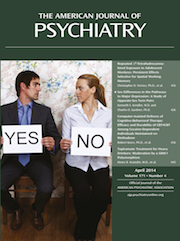In This Issue

Computer-based training for cognitive-behavioral therapy (CBT4CBT; figure) can increase abstinence rates in patients with cocaine dependence enrolled in methadone maintenance and weekly group sessions. The 47 patients randomly assigned to CBT4CBT by Carroll et al. (CME, p. Original article: 436) completed five of seven modules, on average, over 8 weeks of CBT. The proportion of patients abstinent for 3 weeks at the end of treatment was 36% for CBT and 17% for treatment as usual. In an editorial, Freedman (p. Original article: 388) notes that this work incorporates a series of dramatic vignettes, similar in quality to television shows, that allow the patients to identify with others working through similar issues that might lead to drug use. Readers of the Journal online can view a short video demonstration.
Liver dysfunction related to antidepressant use is rare, but it is unpredictable and not always reversible. Liver damage is generally unrelated to dosage and can occur with any antidepressant, but higher risks are associated with iproniazid, nefazodone, phenelzine, imipramine, amitriptyline, duloxetine, bupropion, and trazodone. In most cases, onset occurs between several days and 6 months after the beginning of antidepressant treatment. Most affected patients are clinically asymptomatic, and symptoms overlap with those of depression, e.g., fatigue, asthenia, and anorexia. If liver toxicity is suspected, Voican et al. (p. Original article: 404) recommend discontinuing antidepressants and conducting liver function tests. In most cases, liver function improves after antidepressant treatment is stopped.
Interviewing male-female twin pairs in which one member had major depression revealed sex differences in risk factors. Kendler and Gardner (p. Original article: 426) discovered that personality and problems in interpersonal relationships played stronger etiologic roles in depression for women than for men. Childhood sexual abuse, externalizing psychopathology, prior depression, and acute financial, occupational, or legal stress were more important for men. These sex differences do not extend to response to psychotherapy or medication, notes Weissman in an editorial (p. Original article: 384), but they offer a road map for clinicians in formulating psychological issues important to their patients.
Heavy drinkers who wish to reduce, but not discontinue, alcohol consumption may find this possible while taking topiramate. The study by Kranzler et al. (p. Original article: 445) demonstrated better outcomes for topiramate than for placebo as an adjunct to counseling. The difference occurred only in patients with a specific variation in a gene involved in glutamate neurotransmission, but the difference confirms topiramate’s effect. For patients with the CC genotype of the GRIK1 polymorphism, the number of days with heavy drinking fell to fewer than 1 per week when topiramate was added to counseling, compared with nearly 3 per week without topiramate. In their editorial, Batki and Pennington (p. Original article: 391) cite this finding as evidence that clinicians should expand pharmacotherapy for alcohol use disorders and consider reduced drinking, not just abstinence, as a goal.
Persistent THC Effect on Spatial Memory in Adolescent Monkeys
Adolescent rhesus monkeys administered Δ9-tetrahydrocannabinol (THC) 5 days a week for 6 months showed less practice-related improvement than unexposed monkeys on a test measuring working memory of spatial relationships. The exposed and unexposed monkeys did not differ in memory of colored objects, Verrico et al. (CME, p. Original article: 416) report. The discrepancy between spatial and object memory effects may stem from different developmental trajectories of underlying brain circuits. In an editorial, Corcoran (p. Original article: 381) observes that IQ loss in human marijuana users appears to have a “window of recovery,” i.e., IQ develops normally in regular users who become abstinent in adolescence, but not those who do so as adults.



